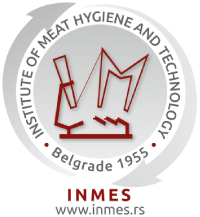Changes in the quality of goat meat in the production of smoked ham
Abstract
The quality of fresh goat meat can be defi ned strictly in terms of physical and chemical properties, or in terms of consumer perception. In Serbia, there is not enough information about the quality of goat meat and goat meat products, such as smoked ham. The aim of this study was to determine differences in the basic chemical composition, colour, fatty acids composition, volatile compounds in fresh meat and smoked ham (musculus gluteus superfi cialis). The meat was obtained from the population of Serbian White goat, fi ve or six years old. ISO methods were implemented in order to determine the quality of these parameters. Statistically signifi cant difference (p < 0.05) was determined between values of protein, fat, moisture, ash, pH value, fatty acids and volatile compounds determined in fresh meat and fi nished product (smoked ham). It is assumed that the complex chemical and biochemical processes occurring during production (growing, curing, smoking, drying) resulted in statistically signifi cant differences between the quality parameters in fresh meat and smoked ham. There was a statistically signifi cant difference (p < 0.05) between the values of capric acid, lauric acid, myristic acid, pentadecanoic acid, pentadecenoic acid, palmitic acid, palmitoleic acid, heptadecanoic acid, stearic acid, oleic acid, linoleic acid, linolenic acid, arachidic acid and gadoleic acid identified in the thigh meat prepared for
curing and smoking in compared to value of the fatty acids identified in the final product (smoked ham).
Key words: goats, meat quality, maturation, curing, smoking.





